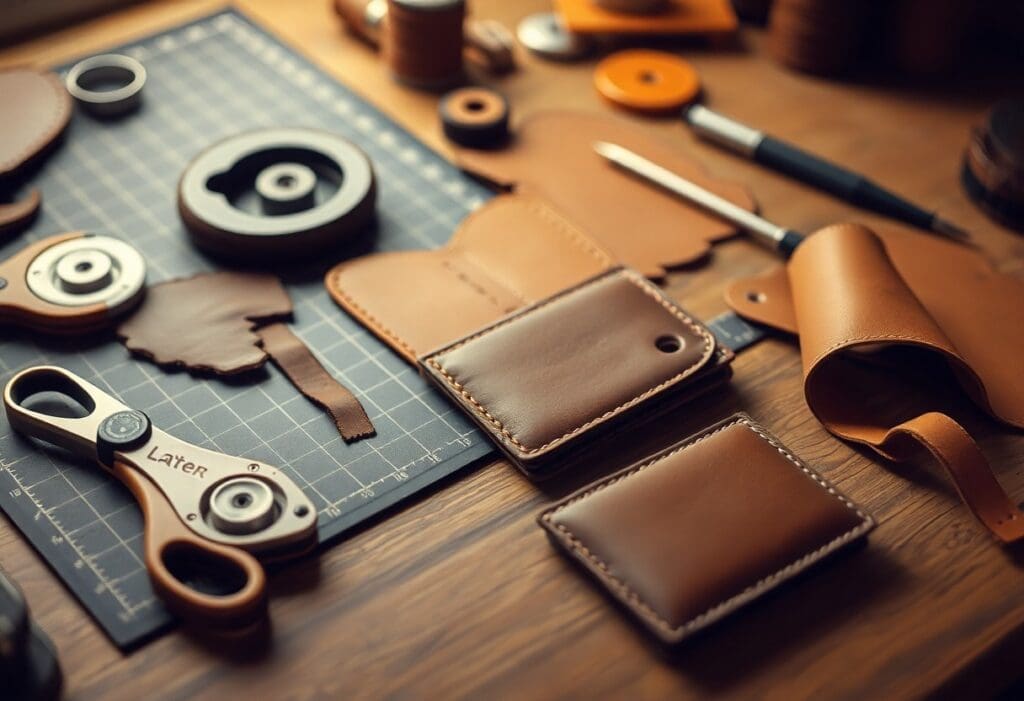Over the years, leathercraft has evolved into a popular and rewarding hobby that allows you to create unique and functional items.
Whether you’re interested in making wallets, belts, or bags, getting started in leathercraft requires the right tools, materials, and techniques.
In this guide, you will learn imperative tips and resources to kickstart your leatherworking journey, empowering you to express your creativity and craftsmanship one stitch at a time.
The Allure of Leathercraft: Understanding the Materials
A Deep Dive into Leather Types: Cowhide vs. Goatskin vs. Exotic Leathers
Each leather type offers unique qualities that cater to different projects.
Cowhide is known for its durability and versatility. It is ideal for everyday items like bags and shoes.
Goatskin boasts a soft texture and natural grain. It is perfect for garments and lightweight accessories.
Exotic leathers, such as snake and alligator, bring an unparalleled aesthetic appeal. However, it often comes with a higher price tag and specific care requirements.
Once you learn what the characteristics are and how they will impact your work, you’ll be able to pick efficiently and intelligently.
In summary, here are things to know about the above three options and a couple more:
| Cowhide | Durable and versatile, common for various items |
| Goatskin | Soft texture, ideal for garments and accessories |
| Exotic Leathers | Unique appeal, often more expensive and high maintenance |
| Vegetable-Tanned | Environmentally friendly, develops patina over time |
| Chrome-Tanned | Soft and pliable, ideal for everyday use items |
The Importance of Quality: Evaluating Leather Grades and Sources
Quality leather is paramount to the longevity and aesthetic appeal of your leather goods.
The grading system often categorizes leather from top grain, which retains the natural grain, to bonded leather, which combines scraps into a single sheet.
Once you understand these grades, you’ll be able to make more informed choices.
Sourcing also matters. Reputable suppliers provide better quality and transparency regarding the leather’s origins.
When you examine leather grades, you’ll be able to recognize the intricacies of quality.
Top-grain leather, considered the highest quality, maintains the natural surface characteristics and is less prone to wear.
Full-grain has similar properties but includes the denser outer layer of hide. This contributes to its enhanced durability.
Lower grades, such as corrected grain and bonded leather, may serve specific budgets but sacrifice authenticity and durability.
Your choice of source can significantly affect quality as well.
Reputable tanneries prioritize ethical sourcing and craftsmanship.
When you choose well, you can feel confident that your purchased leather meets the highest standards and fits your creative vision.
Tools of the Trade: Your Leatherworking Arsenal
Must-Have Tools for Beginners: Knives, Awls, and Punches
Your toolkit is the foundation of your leathercraft journey.
Start with a sharp utility knife for precise cuts. Don’t overlook the importance of an awl for creating holes or guiding stitches.
Punches will protect your leather from unintentional damage, making it easier to create perfect holes for stitching or rivets.
As you get more experienced, you can explore other tools, but these basics set the stage for countless projects.
The Versatility of Leather Adhesives and Finishing Products
To elevate your leathercrafting projects, the right adhesives and finishing products make a remarkable difference.
Leather-specific glue ensures a strong bond. And finishing solutions help you protect your work and enhance its aesthetics.
Adhesives can vary widely, from contact cement for durable joints to water-based options that allow for easy adjustments before setting.
Finishing products, whether dyes, paints, or sealants, add that final touch, sealing the deal on your artistic vision.
High-quality leather adhesives can streamline your workflow significantly.
For example, contact cement is ideal for holistically bonding larger pieces, as it creates a robust hold that withstands various stresses.
On the other hand, when you want more maneuverability, a water-based adhesive leaves room for adjustments until you’re ready to finalize your design.
In terms of finishing products, a clear acrylic sealant can protect your belt from scratches. Meanwhile, a natural dye can infuse vibrant colors to your wallets.
Invest in these products to ensure that your craftsmanship shines while providing longevity in your finished pieces.
Anatomy of a Leather Project: From Concept to Creation
Designing Your Project: Sketching, Sizing, and Planning
Start your leathercraft journey by bringing your ideas to life through sketches.
Outline your design on paper, considering its dimensions and functionality.
Pay attention to details like pockets, straps, and closures, ensuring they are practical and visually appealing.
Draft a drawing to scale, so you can avoid unnecessary material waste and to ensure pieces fit together seamlessly during assembly.
Choosing Patterns: Hand-crafted vs. Commercial Templates
Patterns play a pivotal role in the success of your project.
Hand-crafted patterns offer a unique, personalized touch, while commercial templates provide tried-and-true guidelines for creating popular items.
Both options come with distinct advantages and challenges. You will need to choose based on your experience level, design aspirations, and availability of resources.
Hand-crafted patterns allow for full creativity, enabling you to design something entirely your own from scratch, which can be wholly satisfying.
This approach requires strong skills in drafting and a deep understanding of leatherwork principles.
Conversely, commercial templates are readily available and often come with detailed instructions, making them ideal for beginners.
They provide a structured foundation for building your skills while still leaving space for customization. You can add your own unique flair, such as stitching patterns or material choices.
If you successfully balance the two approaches, you can expect to generate successful and inventive creations, regardless of your skill level.
The Crafting Process: Techniques and Tips for Success
Leathercrafting is an art that combines skill, precision, and a deep understanding of the materials involved.
As you begin your leathercraft journey, your mastery of some key techniques will pave the way for exceptional projects.
Below are tips to help ensure your success:
- Invest in quality tools and materials
- Practice good cutting techniques for clean edges
- Choose the right stitching method for your project
- Use appropriate adhesives for leather
- Don’t skip on finishing touches that enhance durability
These practices will elevate your craftsmanship and result in beautiful, lasting pieces.
Cutting and Shaping Leather: Precision Techniques for Clean Edges
Precision in cutting and shaping leather cannot be overstated.
Use a sharp utility knife or rotary cutter and a straight edge for guidance. This will help you achieve clean lines without tearing.
You’ll want to score the leather first, applying light pressure to create a guide that enhances accuracy.
With careful measuring and marking of your cuts, you can ensure that all the pieces fit together seamlessly.
Mastering Stitching Methods: Saddle Stitch vs. Whip Stitch
You’ll always need to choose the right stitching technique in leathercraft. It affects the durability and aesthetic of your project.
The saddle stitch provides a strong, balanced seam that is ideal for high-stress areas.
Meanwhile, the whip stitch is quicker and simpler, often used for decorative purposes.
Each has its place, and understanding them will enhance your versatility as a leatherworker.
The saddle stitch is created by using two needles on opposite ends of the same thread, which reinforces the seam and doubles the thread’s strength.
This method is commonly favored among artisans for its methodical, reliable nature and ability to withstand tension.
Conversely, the whip stitch enables faster construction, creating a zigzag pattern that showcases creative flair.
You might choose this method for decorative edges on handbags or casual projects.
Ultimately, select a technique that best suits your design’s intention and functional requirements.
Trouble in Paradise: Common Mistakes and How to Avoid Them
The Three Big Mistakes Most Beginners Make
New leathercrafters often fall into a few common traps.
By underestimating the importance of precise measurements, you might end up with uneven pieces or misaligned cuts.
If you neglect to fully understand the tools and materials, it can result in poor finishing or damage to the leather.
Finally, impatience with drying times or stitching can compromise the durability and aesthetics of your final piece.
By addressing these mistakes early on, you can set a solid foundation for your leatherworking journey.
Corrections and Reworking: Salvaging Your Leather Projects
Even with careful planning, mistakes can slip through, but all is not lost.
You’ll want to understand how to correct and rework your leather projects. This can save your efforts and turn failures into successes.
Whether it’s trimming away a flawed area or incorporating creative alterations to disguise an error, there are strategies to breathe new life into your pieces.
Learn to embrace these moments as part of the crafting process. They can enhance your skills and infuse your work with character.
For instance, let’s say you’ve made a cut that’s too deep or off-center. Consider adding decorative stitching or rivets to not only secure the area but also create a unique design element.
If a stain marks your leather, sometimes you can dye the entire piece a darker color to blend imperfections.
By exploring reworking techniques, you’ll develop a more intuitive sense of material and design. This will ultimately improve your craft.
Plus, each salvaged project adds a personal story to your journey, reminding you that mistakes can be a stepping stone to mastery.
Crafting Community: Connecting with Fellow Leather Enthusiasts
Online Forums and Social Media Groups: Finding Inspiration and Support
Online forums and social media groups dedicated to leathercraft can provide you with a wealth of inspiration and encouragement.
Websites like Reddit and Facebook host dedicated communities where you can share your projects, ask questions, and receive feedback from fellow enthusiasts.
By engaging in discussions or simply browsing through others’ work, you will be able to stay current with trends, techniques, and materials.
Classes and Workshops: Learning from Seasoned Artisans
Classes and workshops connect you directly with seasoned artisans who can share invaluable insights.
Whether through local craft centers or online platforms, you can significantly elevate your skills and understanding of leathercraft by studying with experts.
These classes provide hands-on experience and personalized guidance, ensuring you grasp techniques more effectively than through self-study.
Many leathercraft schools and experts offer structured classes that cater to various skill levels, from beginners to advanced crafters.
Workshops may cover specialized topics like saddle making, tooling, or dyeing techniques. These events are a great way for to explore specific aspects of the craft.
You’ll often find opportunities for networking, meeting fellow crafters, and even collaborating on projects.
Look for local leather shops or community centers that host events. Maybe even consider online workshops from well-known crafters to broaden your experience.
Beyond Basics: Advanced Techniques to Elevate Your Craft
As you enhance your leathercraft skills, advanced techniques will take your creations to new heights.
Consider the following methods to refine your craftsmanship:
Dyes and Finishes: Transforming Your Leather’s Appearance
Experiment with dyes and finishes, which will open up a world of color and texture for your leather projects.
You can choose from a variety of dye types, such as alcohol-based, water-based, and eco-friendly options, to achieve the desired effect.
Finishing products enhance the leather’s durability while adding a polished look.
Techniques like burnishing the edges or applying a protective topcoat will set your work apart, making it both functional and visually appealing.
Customization Techniques: Stamping, Carving, and Engraving
If you really want to make each piece truly unique, you will need to learn some customization techniques, including:
- Stamping: create intricate designs
- Carving: provide depth and texture
- Engraving: a refined, permanent method for adding detailed imagery or lettering
Each of these methods enhances your leathercraft and ensures your creations reflect your individual style.
To further explore customization, consider sourcing specific tools for each method.
Stamps come in different shapes and sizes, allowing you to implement patterns that suit your vision.
Carving tools can range from simple knives for basic designs to specialized tools for advanced textures.
You can use engraving plates and techniques to add intricate details that elevate your work from handcrafted to artisanal.
Once you master these techniques, you’ll churn out an end product that embodies your creativity and skill. Each and every piece will be a true reflection of your artistry.
The Art of Selling: Turning Passion into Profit
Pricing Your Work: Balancing Costs with Value Perception
To figure out the right price for your leathercraft, you’ll have to strike a delicate balance between covering your costs and communicating value to your customers.
Analyze materials, tools, and time you spend creating each item. You’ll also need to consider factors like uniqueness and craftsmanship.
Research similar products in your niche to gauge market expectations. You can use this information to set a price that reflects quality without alienating potential buyers.
Online Marketplaces and Craft Fairs: Choosing the Right Sales Channels
Your choice of sales channels can significantly impact your business.
Online marketplaces like Etsy and Amazon Handmade offer vast reach and ease of access. Meanwhile, local craft fairs provide personal interaction and immediate feedback.
Consider your target audience. For instance, younger buyers may prefer online shopping, whereas those seeking unique finds might gravitate towards craft fairs.
Each channel has its benefits and drawbacks, which you’ll want to weigh based on your selling strategy.
By engaging with both online marketplaces and craft fairs, you’ll create diverse opportunities for visibility and sales.
Online platforms like Etsy attract a global audience. There, you can showcase your work to potential buyers who appreciate handmade goods.
In contrast, craft fairs facilitate for face-to-face interactions with customer and immediate feedback, which is invaluable for honing your craft.
By maintaining a presence in both, you will not only expand your reach but also adapt your strategy based on what resonates most with your customers.
Final Words
As you begin on your leathercraft journey, focus on acquiring the important tools and materials that suit your needs.
Familiarize yourself with basic techniques and consider taking online courses or workshops to enhance your skills.
Start with simple projects to build confidence and gradually challenge yourself as you progress.
Engage with the leathercraft community for inspiration and support, and don’t hesitate to experiment with your creativity.
With patience and practice, you will find joy in creating beautiful leather pieces that reflect your unique style.



